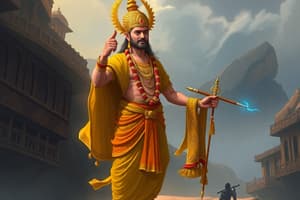Podcast
Questions and Answers
When did the Magadha Empire rise?
When did the Magadha Empire rise?
6th century BCE to 4th century BCE
Who was the founder of the Magadha Empire?
Who was the founder of the Magadha Empire?
- Mahapadma Nanda
- Bimbisara
- Ajatasatru
- Jarasandha (correct)
Bimbisara was an admirer of Mahavira.
Bimbisara was an admirer of Mahavira.
True (A)
What was the capital of Bimbisara's kingdom?
What was the capital of Bimbisara's kingdom?
Which dynasty did Bimbisara belong to?
Which dynasty did Bimbisara belong to?
Who was Ajatasatru?
Who was Ajatasatru?
Ajatasatru convened the First Buddhist Council at ______.
Ajatasatru convened the First Buddhist Council at ______.
Udayin shifted the capital to Pataliputra.
Udayin shifted the capital to Pataliputra.
What was the significant achievement of the Sisunaga dynasty?
What was the significant achievement of the Sisunaga dynasty?
Who was the first ruler of the Nanda Dynasty?
Who was the first ruler of the Nanda Dynasty?
The Nanda Dynasty was the first Kshatriya dynasty of Magadha.
The Nanda Dynasty was the first Kshatriya dynasty of Magadha.
Flashcards are hidden until you start studying
Study Notes
Magadha Empire: Rise and Growth
- The Magadha Empire was a powerful state in ancient India located in modern Bihar.
- The Magadha Empire rose to prominence from the 6th century BCE to the 4th century BCE.
- Key factors for the Magadha Empire's rise: geographical location, fertile land, iron resources, strong army, and strategic alliances.
The Haryanka Dynasty
- The first important dynasty in Magadha was the Haryanka Dynasty.
- Bimbisara (558 BC – 491 BC) was the founder and a key figure in the rise of the Magadha Empire.
- He was a contemporary and follower of the Buddha and Mahavira.
- He expanded his empire through conquest and diplomacy, most notably annexing the Anga kingdom.
- He established his capital at Rajagriha (Rajgir), strategically located and protected by five hills.
- He implemented an efficient administrative system with three branches: executive, military, and judicial.
- Ajatasatru (492 BC - 460 BC), Bimbisara's successor, was known for his ambition and military prowess.
- He killed his father to seize the throne and is credited with conquering Vaishali after a 16-year-long war.
- He embraced Buddhism and convened the First Buddhist Council at Rajagriha.
- He employed advanced war engines like catapults and chariots with maces.
- He strengthened Rajagriha's fortifications to defend against Avanti.
- Udayabhadra/Udayin (460 BCE - 444 BCE), Ajatasatru's son, shifted the capital to Pataliputra (Patna).
- He built a fort at the confluence of the Ganges and Son rivers, strategically located in the heart of the expanding empire.
- He was the last major ruler of the Haryanka dynasty, assassinated by Palaka, the king of Avanti.
The Sisunaga Dynasty
- Following a rebellion during the reign of Nagadasaka, a minister named Sisunaga established the Sisunaga Dynasty.
- This dynasty ruled from 413 BCE to 345 BCE.
- Sisunaga played a crucial role in restoring the Magadha Empire’s power.
- He was the viceroy of Kasi and became the king after Nagadasaka's assassination.
- He focused on consolidating the empire and ending the long-standing rivalry with Avanti.
- He destroyed the Avanti kingdom and brought it under Magadha rule.
- He shifted his capital to Vaishali.
- Kalasoka (also known as Kakavarna), Sisunaga's son, ascended to the throne.
- He shifted the capital back to Pataliputra.
- He is known for convening the Second Buddhist Council at Vaishali.
- He was killed in a palace revolution that ended the Sisunaga dynasty and paved the way for the Nanda dynasty.
The Nanda Dynasty
- The Nanda dynasty, originating from a non-Kshatriya background, ruled from 345 BCE to 321 BCE.
- Mahapadma Nanda was the founder of the Nanda dynasty.
- He usurped the throne from the last Sisunaga king, Kalasoka, through assassination.
- He is considered the “first historical emperor of India,” albeit before Chandragupta Maurya.
- His origin is debated, with sources claiming him to be the son of a Sudra woman or a barber and courtesan.
- The Nanda dynasty expanded the Magadha Empire's territorial boundaries.
- However, they are known for their harsh taxation policies and the use of a large standing army.
Importance for UPSC Exam
- The rise of the Magadha Empire is crucial for understanding the evolution of political power dynamics in ancient India.
- The Haryanka and Sisunaga dynasties laid the groundwork for the Mauryan Empire's later rise.
- The Nandas, although relatively short-lived, left a lasting mark on Indian history as the first non-Kshatriya dynasty to rule a large empire.
- Understanding the Magadha Empire provides a deeper perspective on ancient India's social, political, and economic structures.
- Information about the Magadha Empire can be useful for both ancient history sections in the Prelims exam and the GS-I paper for the Mains Exam.
Studying That Suits You
Use AI to generate personalized quizzes and flashcards to suit your learning preferences.




